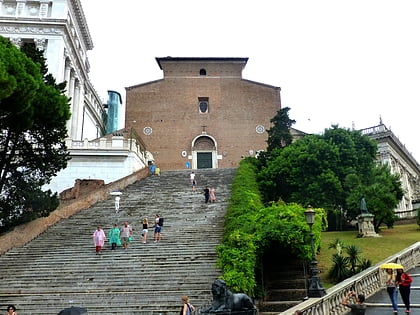Capitoline Hill, Rome

Facts and practical information
Perched on one of the Seven Hills of Rome, Capitoline Hill (or Campidoglio in Italian) stands as a testament to the grandeur of Rome's historical legacy. This ancient site, nestled in the heart of the city, has been a focal point of Roman life for thousands of years, resonating with political, religious, and artistic significance.
Capitoline Hill is not just a historical place; it is an embodiment of Rome's layered history. It was once the citadel of the earliest Romans and later the site of the most important temples, including the Temple of Jupiter Optimus Maximus. Today, the hill is dominated by the Piazza del Campidoglio, a stunning Renaissance square designed by the legendary artist and architect Michelangelo Buonarroti in the 16th century. Michelangelo's harmonious design provides a remarkable example of urban planning, blending the classical with the innovative.
Visitors to Capitoline Hill are greeted by the impressive Cordonata Capitolina, a gently sloping staircase leading up to the piazza, flanked by ancient statues of Castor and Pollux. At the center of the square stands the equestrian statue of Emperor Marcus Aurelius, a bronze masterpiece that is a replica of the original preserved in the Capitoline Museums.
The Capitoline Museums, located on the hill, are a treasure trove for history and art lovers. The museums are housed in two palazzi surrounding the square - the Palazzo dei Conservatori and the Palazzo Nuovo. Together, they form one of the oldest public collections of art in the world, showcasing an extensive array of ancient Roman statues, inscriptions, and artifacts, as well as a collection of Renaissance and Baroque paintings.
For those seeking panoramic views, the terrace of the Capitoline Hill provides a breathtaking vista over the Roman Forum and the city beyond. The view from the top captures the essence of Rome's ancient splendor and modern vibrancy.
Capitoline Hill – popular in the area (distance from the attraction)
Nearby attractions include: Mamertine Prison, Temple of Vespasian and Titus, Theatre of Marcellus, Arch of Septimius Severus.
Frequently Asked Questions (FAQ)
Which popular attractions are close to Capitoline Hill?
How to get to Capitoline Hill by public transport?
Bus
- Ara Coeli/P.za Venezia • Lines: 118 (2 min walk)
- Ara Coeli/Piazza Venezia • Lines: 130F, 30, 40, 44, 44F, 492, 62, 628, 63, 64, 70, 781, 81, 87, C3, H, n15, n20, n5, n7, n8 (4 min walk)
Tram
- Venezia • Lines: 8 (5 min walk)
- Arenula/Min. G. Giustizia • Lines: 8 (10 min walk)
Ferry
- Isola Tiberina • Lines: Battelli di Roma (10 min walk)
- Ponte Cavour (24 min walk)
Metro
- Colosseo • Lines: B (13 min walk)
- Cavour • Lines: B (16 min walk)
Trolleybus
- XX Settembre/Min. Finanze • Lines: 90 (30 min walk)
- Volturno/Cernaia • Lines: 90 (32 min walk)
Light rail
- Roma Termini • Lines: Fl6, Fl7 (31 min walk)
Train
- Roma Termini (31 min walk)








 Metro / Tram / Rail
Metro / Tram / Rail









